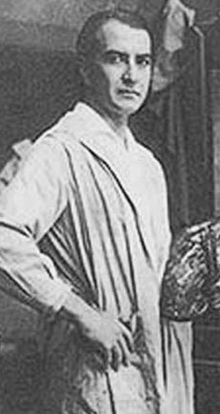Felipe Cossío del Pomar facts for kids
Quick facts for kids
Felipe Cossío del Pomar
|
|
|---|---|

Felipe Cossío in his studio in Paris in 1928
|
|
| Born | 31 May 1888 Piura, Peru
|
| Died | 25 June 1981 (aged 93) Lima, Peru
|
| Occupation | Painter |
| Known for | Founder of Instituto Allende |
Felipe Cossío del Pomar (born May 31, 1888 – died June 25, 1981) was a talented painter from Peru. He was also a political activist who wanted to make society fairer for everyone. When he had to leave Peru, he started an art school in Mexico in 1938. This first school didn't last, but he later founded a new, very successful art school called the Instituto Allende in 1950. This school was still teaching art students in 2014! You can even find a short film about him called "Felipe Cossio del Pomar in San Miguel de Allende" by Ezequiel Morones on YouTube.
Contents
Felipe Cossío's Early Life
Felipe Cossío del Pomar was born on May 31, 1888, in Piura, a city in northern Peru. His family had connections to important people in Peru. For example, he was related to Paul Gauguin, a famous painter.
He went to school in Lima and finished in 1904. Then, he started studying literature at the Universidad de San Marcos. His parents hoped he would become a lawyer. So, in 1906, he traveled to Europe to study law at the University of Leuven.
However, Felipe decided to stay in Brussels instead. He enrolled at the Free University to study fine arts for three years. After that, he lived and worked as an artist in Paris until World War I began in 1914. In Paris, he became friends with other famous artists like Pablo Picasso, Marc Chagall, and Henri Matisse.
Art and Politics
In 1917, Cossío moved to the USA. There, many people wanted him to paint their portraits in his modern style. He returned to Peru in 1921 and continued his studies in Cuzco. During this time, he became good friends with Víctor Raúl Haya de la Torre, a political leader.
In 1922, Felipe earned a degree in literature. His main project was about the history of painting in Cuzco. This work later became a book about colonial painting in the city.
Haya de la Torre was forced to leave Peru in 1923. In 1924, a new political group called the Alianza Popular Revolucionaria Americana (APRA) started forming in different countries. By 1925, Cossío was back in the USA. He helped the APRA group gain support there.
Cossío visited Haya de la Torre in Mexico City. While there, he met the painter Diego Rivera. Rivera showed him the unique shapes and colors of traditional Aztec art. In 1927, Cossío del Pomar visited San Miguel de Allende in Mexico. He loved the beautiful light there.
In 1929, Cossío del Pomar went back to Europe. He lived in Brussels, Florence, and Paris. In France, he worked with surrealist artists like André Breton and Louis Aragon.
By 1931, Cossío was back in Peru. He helped organize the APRA political group. He also used his influence to improve art education. He wanted art to be taught at a higher level, not just as a simple trade.
In 1932, Haya de la Torre was put in prison and faced serious threats. Cossío del Pomar moved to other South American cities like Buenos Aires and Santiago. By 1935, Cossío was on a special list. This meant he would be arrested if he returned to Peru, and his books were banned.
Starting Art Schools in Mexico
In 1937, Cossío del Pomar returned to Mexico. He decided to open an art school in San Miguel de Allende. He used an old convent building that had been a military barracks. With help from President Lázaro Cárdenas, the government gave the property to the school. The school opened in 1938 and was called the Escuela Universitaria de Bellas Artes.
An American artist named Stirling Dickinson became the director of art studies. Many students came to the school, which helped the town of San Miguel de Allende become more successful.
In 1945, Cossío del Pomar went back to Peru when the government allowed exiles to return. He sold his property in Mexico, including the school and a ranch, to a lawyer from Mexico City.
The Instituto Allende
Cossío returned to San Miguel de Allende in 1950. He found that the first school he started had been ruined. So, he decided to create a new one. He got help from Enrique Fernández Martínez, a former governor, and his wife, Nell Harris.
Cossío and Fernández bought a beautiful old palace from the 1700s. They fixed up the building and also opened small houses and a hotel for visitors. This new school was named the Instituto Allende. Stirling Dickinson became the art director again.
Later Years and Legacy
Cossío stayed in Mexico until 1954. Then, he moved to Madrid, Spain. He lived there until 1959. After the Cuban Revolution was successful, he moved to Havana, Cuba.
However, he didn't agree with the new ideas of the revolution. So, in 1961, he moved back to Spain, to a town called Gandia. This was a very busy time for Cossío. He created many artworks and wrote many books.
In 1980, at 92 years old, he returned to live in Peru. He passed away the next year in Lima. He had arranged for his body to be buried in his hometown of Piura. He also left his personal art collection to the city. This collection was meant to help create the Museum of Art in Piura.
Sources

